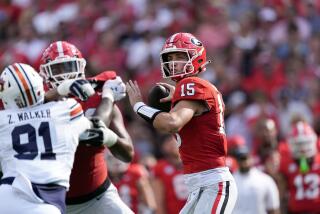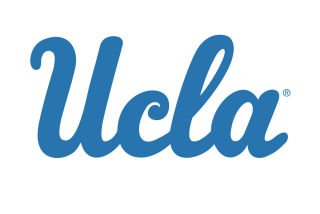NCAA Ratifies Drug Tests for Championship Events
NEW ORLEANS — There was hardly any discussion, much less lively debate, on a monumental piece of legislation passed at the NCAA convention Tuesday. It established drug testing for athletes competing in national championship competitions and postseason football games.
Bickering about how many wallet-sized schedules could be sent to recruits commanded more time on the floor than Proposal 30, which established drug testing. It also listed the stimulants, anabolic steroids, diuretics and street drugs that would be banned; outlined disciplinary action for student-athletes who test positive and for members of athletic departments who know of the use of banned substances and do not follow the correct institutional procedures; required athletes to sign consent for testing annually, and even outlined how the astronomic costs will be shared between the schools and the NCAA.
All sections passed overwhelmingly by a show of voting paddles.
Testing will begin in the fall.
The sweeping success of the proposal did not indicate, however, that no delegates had reservations or questions about drug testing. It indicated, rather, the same kind of evangelistic approach to reform that was practiced at the special convention on integrity here last June.
As Michael Johnson, the faculty representative at the University of Houston put it: “I think they were afraid to vote against motherhood.”
UCLA Athletic Director Pete Dalis said: “I think, too, there is a certain amount of guilt about not having addressed, before this, the kind of issues that they think society is interested in.”
Again, as at the special convention last June, Southern Methodist was one of the few schools standing against the majority.
SMU faculty representative Dr. Lonnie Kliever said: “This does not indicate, in any way, that we do not approve of drug testing. We have had what we consider to be a model program at SMU. We’ve been doing our own testing for a couple of years.
“But our program takes a positive approach. It centers around rehabilitation. We ensure confidentiality. Our goal is to help, not to embarrass, these people.
“We think this can be handled best at the institutional level.”
Later in the day the delegates approved a proposal that will permit, but not require, a school to pay an athlete’s cost of rehabilitation.
Kliever said: “What we have found is that the drug problem is not a major one. I think the more extensive testing will show that, too.
“I am concerned about the image created by extensive drug testing. It gives the impression that there is a widespread problem.”
Walter Byers, executive director of the NCAA, expressed much stronger concern about the drug problem, saying that as a result of his meetings with the Drug Enforcement Administration and with the Olympic Committee on the subject, he believes the problem is a huge one. He cited a recent statement by Atty. Gen. Edwin Meese that the Justice Department is losing the war against street drugs.
Byers added: “Someone had to step in and break the chain of use of anabolic steroids in the high schools in order to get a college scholarship, and the use of anabolic steroids in colleges to get a pro contract.”
The rule states that an athlete who tests positive for a banned substance will be ineligible for postseason competition for a minimum of 90 days. If the athlete tests positive again after regaining eligibility, he or she will be ineligible for one season of postseason eligibility in all sports and will remain ineligible for postseason competition at least through the next academic year.
Half of the cost of the testing will be considered an expense of the tournament and will be deducted from the gross receipts before they are divided among the participating teams. The other half will be paid by the NCAA.
As for bowl games, the not-yet-completed plan would have the NCAA pay half the total cost. The other half would be divided between the bowl committee, which would pay one-quarter of the remaining cost, and the two competing teams.
The cost for testing one athlete is estimated to be $200. So football players would be tested at random, probably 36 on each team.
The estimate of the cost to the NCAA for all testing next season is $310,000.
It would seem that every part of Proposal 30 was worthy of exhaustive debate, but most of the issues and concerns were discussed at this convention last year, and the proposal, as it appeared on the agenda, was offered by the NCAA Council as a result of a year’s work by the Special NCAA Committee on National Drug-Testing Policy.
In other words, it was pre-debated and inevitable.
The liveliest debate on a significant topic concerned the attempt to raise the limitations on how much spending money athletes could receive from a Pell grant.
A Pell grant is federal money that any student, athlete or otherwise, can apply for to further his education. It is based on need and can total up to $2,100. Many athletes qualify for Pell grants, but according to NCAA rules, the athletes may keep only $900 for spending money, the rest going to the athletic department to decrease the cost on their scholarship.
Doug Weaver, athletic director at Michigan State, said that it was extremely difficult to explain to an athlete why he cannot keep money that the federal government has sent him because it has to be used to pay for a scholarship that he thought was the responsibility of the athletic department. “You sound like Professor Backward,” Weaver said.
Weaver was speaking in support of letting those athletes who have received grants based on need keep that money. “This is one of the rare chances we get to allow them benefits,” he said. “This (book) is full of rules against treating athletes with special benefits that other students do not have. This is just the opposite.
“What we are doing by taking their money and applying it against their scholarships makes “The Sting” look like the Salvation Army.”
Apparently he was not persuasive. The delegates voted against allowing athletes to keep their entire Pell grants, and then voted against raising the amount they are allowed to keep from $900 to $1,400.
Judith Holland, associate athletic director at UCLA, said that the $1,400 was not an arbitrary figure but one that was determined in a study of how much spending money the average student needs for a year in school.
The vote on the proposal to allow athletes with need to keep $1,400 of their Pell grants was close, with most of the Division I schools voting for it, but with the Division II and Division III schools voting against it.
Many of the schools voting against raising the maximum amount do not let their athletes keep the current maximum of $900. Too many of the smaller schools need the Pell grant money to keep their programs running.
Dick Hill, athletic director at Southern University in Baton Route, La., said he believed in letting athletes keep more spending money. “It is true that all institutions need to administer cost-effective athletic programs, but they should not be driven by ‘entitlement’ moneys,” he said.
“Those institutions need to find other ways of raising funds. The athletes need that money.”
Commenting on the schools that voted down the Pell grant revisions, LSU Athletic Director Bob Brodhead said: “They don’t care about the athletes. That (money) is the athlete’s right. That’s not institutional money.
“They’re playing right into the hands of the radicals who want a players’ association.”
On a close vote, the proposal to reduce from eight to seven the number of sports required for men and women to qualify as a member of Division I-A did pass.
The Southwest Conference schools sponsored a proposal that was designed to eliminate alumni from all recruiting contact with prospective athletes, but as it was being modified to clearly limit contact not only to institutional staff members but also current student-athletes and other students, the question was posed: “What’s to prevent a booster from signing up for a one-hour class to become a student?”
With that, the proposal was referred to the council for further study.
The delegates did pass legislation that will hold prospective athletes responsible for their parts in recruiting violations. Violations of recruiting rules could cost a student-athlete loss of eligibility.
Also approved was a resolution to ask President Reagan’s Commission on Organized Crime to recommend strengthening federal legislation against gambling on intercollegiate athletics.
In summing up after the convention ended--in two days instead of the projected three--Byers, cited as the most important issues the actions to establish academic standards, “the most forthright action of any sports organization in the country” in dealing with drugs and the stand against gambling.
More to Read
Go beyond the scoreboard
Get the latest on L.A.'s teams in the daily Sports Report newsletter.
You may occasionally receive promotional content from the Los Angeles Times.










